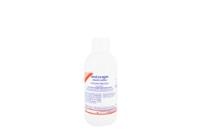

CHLORHEXLAN 20 mg/ml CUTANEOUS SPRAY SOLUTION

Ask a doctor about a prescription for CHLORHEXLAN 20 mg/ml CUTANEOUS SPRAY SOLUTION

How to use CHLORHEXLAN 20 mg/ml CUTANEOUS SPRAY SOLUTION
Introduction
ProspectusInformationfor the User
C
chlorhexidine digluconate
Read the entire prospectus carefully before starting to use this medication, as it contains important information for you
Follow the administration instructions for the medication contained in this prospectus or as indicated by your doctor or nurse exactly.
- Keep this prospectus, as you may need to read it again.
- If you need advice or more information, consult your doctor or nurse.
- If you experience adverse effects, consult your doctor or nurse, even if they are adverse effects that do not appear in this prospectus. See section 4.
Contents of the Prospectus
- What is Clorhexlan and what is it used for.
- What you need to know before starting to use Clorhexlan
- How to use Clorhexlan
- Possible adverse effects
- Storage of Clorhexlan
- Content of the packaging and additional information
1. What is Clorhexlan and what is it used for
Clorhexlan 20 mg/ml is a solution for cutaneous use whose active ingredient is chlorhexidine digluconate.
It is used in adults and children as a skin antiseptic, for the prevention of infections, before performing invasive medical procedures, such as injections, insertion of intravascular catheters, minor and major surgery.
2. What you need to know before starting to use Clorhexlan
Do not use Clorhexlan
If you are allergic (hypersensitive) to chlorhexidine digluconate or to any of the other components of this medication (included in section 6).
Warnings and precautions
Consult your doctor or nurse before starting to use this medication.
Clorhexlan is for external use on the skin only. Do not ingest.
Clorhexlan should not be used:
- Near sensitive areas (mucous membranes), as it may cause irritation. In case of contact with the mucous membranes of the body's entry points, the affected area should be washed immediately with plenty of water.
- Clorhexlan should not come into contact with the eyes due to the risk of visual damage. If it comes into contact with the eyes, wash immediately and abundantly with water. In case of irritation, redness, or pain in the eyes, or visual disturbances, consult a doctor immediately.
Severe cases of persistent corneal injury (injury to the surface of the eye) that could require a corneal transplant have been reported when similar products have accidentally come into contact with the eyes during surgical interventions, in patients under general anesthesia (deep sleep induced without pain).
- On open wounds.
- On the inner part of the ear (middle ear).
- In direct contact with neural tissue (e.g., brain and spinal cord).
Avoid prolonged contact with the skin. When applying an occlusive dressing to areas previously exposed to Clorhexlan, special care should be taken to ensure that there is no excess product before placing the dressing.
Do not use excessive amounts and avoid accumulating the solution in skin folds, under the patient, or soaking bedding or other materials in direct contact with the patient.
Soaked materials, such as surgical fields or gowns, should be removed before use. Do not let the solution stagnate.
Clorhexlan may, in rare cases, cause severe allergic reactions, leading to a decrease in blood pressure and even loss of consciousness. The first symptoms of a severe allergic reaction may be skin rash or asthma. If you notice these symptoms, stop using this medication and contact your doctor as soon as possible (see section 4: "Possible adverse effects").
Children
Use with caution in neonates, especially in premature babies. Clorhexlan as a skin antiseptic before invasive procedures may cause chemical burns on the skin of neonates.
Use with caution in neonates, especially in those born before 32 weeks of gestation and in the first two weeks of life.
Other medications and Clorhexlan
The action of chlorhexidine is reduced by alkaline pH, anionic detergents, and tannins:
- In general, considering possible interference (antagonism, inactivation, etc.), the simultaneous or successive use of antiseptics should be avoided, except with other cationic compounds.
- It should not be used in combination or after the application of anionic soaps, iodine, heavy metal salts, and acids.
Pregnancy, breastfeeding, and fertility
If you are pregnant or breastfeeding, think you may be pregnant, or plan to become pregnant, consult your doctor or nurse before using this medication.
Driving and using machines
Clorhexlan does not alter the ability to drive or operate machines.
3. How to use Clorhexlan
Your doctor or nurse will select the necessary amount of solution based on the medical procedure, the area to be treated, and the area to be covered. In case of doubt, ask your doctor or pharmacist.
Use undiluted. Clean and dry the skin before applying the medication. Apply directly to the affected area or to a gauze. Let it act for the time indicated based on the medical procedure.
Clorhexlan is only used on the skin.
If you use more Clorhexlan than you should
In case of overdose or accidental ingestion, consult your doctor or pharmacist immediately or call the Toxicology Information Service, phone: 91 562 04 20, indicating the medication and the amount ingested.
4. Possible adverse effects
Like all medications, this medication may cause adverse effects, although not all people experience them.
Stop treatment with this medication if you experience any of the following symptoms: swelling of the face, lips, tongue, or throat; red eczema on the skin that causes itching; difficulty breathing; feeling of dizziness or fainting, metallic taste; collapse. You may be experiencing an allergic reaction if these symptoms appear.
Stop using this medication and consult your doctor or nurse if you experience eczema, blisters, inflammation, or experience pain or itching in the area of the skin where the product has been applied.
Other possible adverse effects are:
Very rare (less than 1 in 10,000 people):cutaneous hypersensitivity reactions (including erythema, rash, itching, and blisters at the administration site), burning sensation on the skin, pain, and inflammation. Stop using this medication and seek immediate medical attention if you experience any of the adverse reactions described. You may be having an allergic reaction.
Adverse effects of unknown frequency(cannot be estimated from the available data): dermatitis, eczema, urticaria, skin irritation, blisters, chemical burns in neonates, hypersensitivity reactions, and anaphylactic shock during anesthesia. Corneal injury (injury to the surface of the eye) and permanent eye injury, including permanent visual impairment (after accidental ocular exposure during surgical interventions in the head, face, and neck) in patients under general anesthesia (deep sleep induced without pain).
Reporting adverse effects:
If you experience any type of adverse effect, consult your doctor or nurse, even if it is a possible adverse effect that does not appear in this prospectus. You can also report them directly through the Spanish Pharmacovigilance System for Human Use Medications: https://www.notificaram.es. By reporting adverse effects, you can contribute to providing more information on the safety of this medication.
5. Storage of Clorhexlan
No special storage conditions are required.
Keep this medication out of sight and reach of children.
Do not use this medication after the expiration date that appears on the label after CAD. The expiration date is the last day of the month indicated.
Discard the packaging after 3 months from the first opening.
Medications should not be thrown away through the sewers or in the trash. In case of doubt, ask your pharmacist how to dispose of the packaging and medications that are no longer needed. This way, you will help protect the environment.
6. Content of the packaging and additional information
Composition of Clorhexlan
- The active ingredient is chlorhexidine digluconate. Each ml contains 20 mg of chlorhexidine digluconate. Each ml corresponds to 5 pulses of 200 microliters, each containing 4 mg of chlorhexidine digluconate.
- The other component (excipient) is purified water.
Appearance of Clorhexlan and content of the packaging
Colorless or slightly yellowish transparent solution presented in high-density polyethylene bottles with a spray pump.
It is presented in:
- Unitary packages of 25 ml, 100 ml, and 125 ml.
- Clinical packages of 20 bottles of 100 ml, 125 ml, and 250 ml.
Only some packaging sizes may be marketed.
Marketing authorization holder and manufacturer
LAINCO, S.A.
Avda. Bizet, 8-12 - 08191 RUBÍ - Barcelona (Spain)
Date of the last revision of this prospectus:August 2024
Detailed information about this medication is available on the website of the Spanish Agency for Medicines and Health Products (AEMPS) http://www.aemps.gob.es/
- Country of registration
- Active substance
- Prescription requiredNo
- Manufacturer
- This information is for reference only and does not constitute medical advice. Always consult a licensed doctor before taking any medication. Oladoctor is not responsible for medical decisions based on this content.
- Alternatives to CHLORHEXLAN 20 mg/ml CUTANEOUS SPRAY SOLUTIONDosage form: TOPICAL SOLUTION, 20 mg/mlActive substance: chlorhexidineManufacturer: Vesismin S.L.U.Prescription not requiredDosage form: EMULSION, 20 mg/mlActive substance: chlorhexidineManufacturer: Vesismin S.L.U.Prescription not requiredDosage form: TOPICAL SOLUTION, CHLORHEXIDINE DIGLUCONATE 10 mg/mlActive substance: chlorhexidineManufacturer: Laboratorios Bohm S.A.Prescription not required
Alternatives to CHLORHEXLAN 20 mg/ml CUTANEOUS SPRAY SOLUTION in other countries
The best alternatives with the same active ingredient and therapeutic effect.
Alternative to CHLORHEXLAN 20 mg/ml CUTANEOUS SPRAY SOLUTION in Poland
Alternative to CHLORHEXLAN 20 mg/ml CUTANEOUS SPRAY SOLUTION in Ukraine
Online doctors for CHLORHEXLAN 20 mg/ml CUTANEOUS SPRAY SOLUTION
Discuss dosage, side effects, interactions, contraindications, and prescription renewal for CHLORHEXLAN 20 mg/ml CUTANEOUS SPRAY SOLUTION – subject to medical assessment and local rules.














